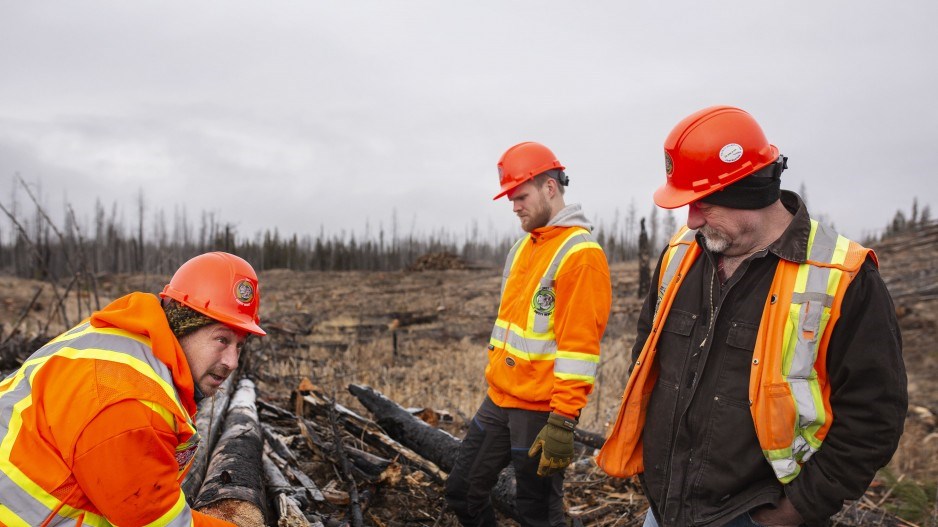If harvested quickly enough, the removal of timber left behind after a wildfire can reduce the risk of future fires and provide much-needed fibre supply to an industry facing a long-term decline.
But in B.C., a lot of this timber goes to waste.
Meanwhile, a significant amount of B.C. lumber is exported to the U.S. – where it gets hit with tariffs and duties – when more of it could be used at home to support the use of wood in construction, under the right policy framework.
At a forestry panel discussion at the BC Natural Resources Forum in Prince George earlier this month, some innovative ideas were proposed for boosting B.C.’s fibre supply and increasing the local demand for lumber and other wood products.
Wood products account for about 13 per cent of the spending in construction in B.C., said Rick Jeffery, president of the Canadian Wood Council. He suggested B.C. follow the Scandinavian model, where wood accounts for 21 per cent of construction inputs and costs.
“That means going from 1,200 wood buildings a year to 2,200 wood buildings a year,” Jeffery said.
Creating a larger domestic market for lumber and other wood products would help industry avoid the higher transportation costs associated with exporting lumber to the U.S. – as well as the associated transportation emissions. It would also avoid American softwood lumber duties.
Jeffery said the B.C. government has lobbied for changes to Canada’s National Building Code that would raise the limit on tall wood buildings from 12 to 18 storeys. That would go some way to increasing wood content in domestic construction, he said.
The BC NDP government has promoted the idea of increasing higher-value-added wood manufacturing in B.C. – such as manufacturing engineered wood products for mass timber construction. But as Jeffery noted, it can cost up to $200 million to build a new mass timber manufacturing plant on the scale that Europe builds them.
“If you’re going to make a $200 million investment, you’ve got to know that you have the fibre available,” Jeffery said.
And unfortunately for B.C., the fibre supply is shrinking, partly due to the Mountain pine beetle epidemic that wiped out so much merchantable timber in B.C.
Increased wildfires are making the problem even worse, but wildfires could also be part of the solution, said Bruce Blackwell, principal of Blackwell and Associates.
He said the area burned in B.C. over the past four decades has grown exponentially.
“Now, that area burned isn’t just a result of climate change,” he said. “It’s also a result of 100 years of successful fire suppression policy, and a fuel grid that really is vulnerable to significant wildfire behaviour during periods of drought.”
If loggers can get in quickly enough after a fire, some timber can be salvaged to feed sawmills and pulp and pellet mills. Blackwell said wildfire salvaging could generate as much as five million cubic metres of fibre each year – about 11 per cent of the province’s total annual allowable cut of 46 million cubic metres.
But after about a year, fire-damaged trees dry out, crack and become useless for any kind of sawmilling.
“We’re losing the fibre opportunity, generally speaking, within one year,” Blackwell said. “If we can’t plan and execute to harvest and salvage that damaged fibre, it degrades very quickly over time.
“When you compare the permitting opportunities in Alberta, it’s about 60 days,” Blackwell said. “Here in B.C., some of the bigger licensees … are having great success, but others are not getting that salvage opportunity for a year, year and a half.
By then, he said, “the value of the fibre has been lost.”
At the same time, failing to salvage wood after a fire leaves a lot of “fuel” behind that could eventually lead to a “reburn,” he warned.
Steve Kozuki, executive director of the Forest Enhancement Society (FES), agreed that there would be fairly significant volumes of timber to be had, if it could be harvested quickly enough.
“If we salvaged all the fire-killed wood right away, before it dried out, then yeah that would make a whole bunch of fibre available to the market that otherwise currently is just being left to go to waste,” he said.
“He’s right, and we have taken steps to speed it up,” B.C. Forests Minister Bruce Ralston said of Blackwell’s proposals.
“The attitude towards burned wood has changed, and companies actively seek it just because of the fibre pressure on companies. So there’s demand for it, and we’re meeting that demand by speeding up the process.”
He said the province has created new wildfire salvage opportunity agreements for First Nations that include speeding up tenuring and timber pricing to allow these sorts of salvaging operations to occur more quickly.
“I’ve heard from people about what they regard as a slower process,” Ralston said. “I’ve expressed my view, and given direction that the process will be faster.”
In addition to post-fire salvaging, there are also opportunities to provide wood fibre through preventative forestry – cutting and thinning trees and forest debris in high-hazard areas to reduce the chance of forest fires.
The B.C. government’s Provincial Strategic Threat Analysis has estimated that there is about one million hectares of fire hazards in urban areas in B.C. The FES has been working with communities and First Nations on this kind of fire-preventative forestry.
“In over 120 communities, we’ve helped reduce their wildfire risk,” Kozuki said.
A year ago, the B.C. government provided the FES with $50 million in funding for forest enhancement projects focused on waste-wood utilization and wildfire-risk reduction. Since then, 66 projects were approved. The amount of fibre that is expected to be harvested or recovered is estimated to be three million cubic metres, most of which would go to pulp and pellet mills.




